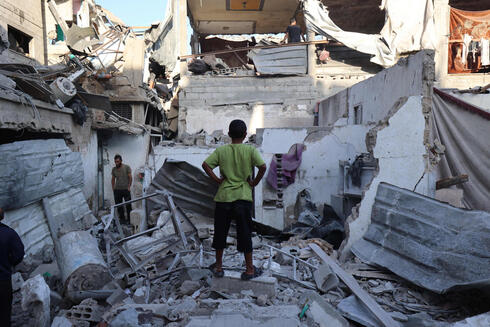Copyright ynetnews

In recent weeks, senior Israeli officials and security agencies have been holding intensive discussions about how to manage Gaza’s imminent reopening to the world. With international forces expected to enter the Strip to assist in locating the hostages and the bodies that Hamas claims are no longer in its possession, Israel is bracing for the arrival of foreign journalists who will, for the first time, see the destruction with their own eyes rather than through Hamas-produced footage. The state told the Supreme Court that Israeli and foreign journalists will soon be permitted to enter Gaza under Israel Defense Forces escort, up to the boundary known as the “yellow line.” The announcement came during a High Court hearing on a petition filed by the Foreign Press Association challenging the government’s restrictions on coverage from within the Strip. Although the state requested and received an extension to file its formal response, the change appears imminent. Officials across Israel’s public diplomacy establishment are preparing for what they describe as an oncoming wave of negative reports focusing on “human stories” from Gaza. These stories, they say, will likely feature the suffering of civilians amid the devastation and could reignite criticism of Israel’s conduct during the war. According to those involved in the effort, the Foreign Ministry and the National Public Diplomacy Directorate are also preparing for Hamas’ expected use of the situation to advance a propaganda campaign accusing Israel once again of war crimes. A large strategy session was recently convened by the IDF Spokesperson’s Unit with representatives from the Foreign Ministry, the National Public Diplomacy Directorate, and other agencies. Foreign Ministry Director-General Eden Bar Tal took part in the meeting. Officials emphasized that although a ceasefire is in place, “the diplomatic and informational battles are far from over.” One Foreign Ministry source said, “On the contrary, we expect intensified anti-Israel attacks on social media and in traditional media outlets.” A senior official involved in the planning described the mission as “a central task for every branch of the system.” The challenge, he said, is clear and significant, especially because of the widespread destruction visible in Gaza. “We are working to prepare explanatory materials, with an emphasis on visual and incriminating evidence to illustrate that Hamas turned Gaza into a terror state, cynically using civilians and civilian infrastructure,” he said. Since the ceasefire, criticism of Israel abroad has eased and coverage of the conflict has largely disappeared from front pages. Israeli public diplomacy officials now expect that the reopening of Gaza to international reporters will bring the story back into global focus. One idea under review is the establishment of designated sites in Gaza where journalists can be shown how Hamas operated from within civilian areas and hid behind noncombatants. Officials say that if the plan is approved, several “demonstration sites” will be created to provide clear visual explanations. “It’s unclear how much new evidence will be found, because the images have already spread around the world,” one senior source said. “But this will be the first time that foreign crews enter Gaza, and they will go building by building, presenting difficult stories. We are preparing for every possible scenario. The assumption is that information will come from sources seeking to dramatize events against Israel, with the destruction serving as the backdrop. They’ll show the ruins and point to Israel as responsible — but Israel’s message is unequivocal: Hamas bears the responsibility. This is consistent with international law, even if it doesn’t look good on camera. Hamas hid beneath schools and hospitals. It was the only way to reach the terrorists. Any other country would have acted the same — or worse.” Officials noted that approximately 60 percent of Hamas’ tunnel network remains standing even two years after the war, evidence they say will help demonstrate the scale of Hamas’ military infrastructure within civilian areas. “The only way to reach Hamas military targets was through homes,” one said. “The terrorists emerged from civilian houses — that’s the reality.” Another senior official described the destruction in Gaza as “fertile ground for anti-Israel campaigns that will lead to protests abroad.” He added, “We need to make clear that this was a terror state. For 20 years, Hamas built terror infrastructure on top of civilian infrastructure. It exploited schools, mosques, and residential buildings. The IDF and Military Intelligence are working hard to gather the incriminating material needed to support this message. We especially need visual evidence. When we take journalists on tours, we must explain what happened — here was a tunnel shaft there, a hostage was held.” At the same time, Israel is preparing for the expected renewal of the “numbers debate” over Gaza’s death toll — how many terrorists were killed versus civilians. Officials say it is critical to present accurate data that Israel can stand behind. “We must show how many so-called civilian deaths were actually natural deaths unrelated to the fighting, even though Hamas claims they were war casualties,” one source said. “Our assessments indicate that the ratio of civilian to terrorist deaths is very low, especially for a conflict of this intensity. That will be an important point to make.” Not all officials are convinced that Israel’s preparations are adequate. One senior figure said, “Unfortunately, I don’t see real readiness. The international media have already published photos of the destruction and the death toll figures released by Hamas’ health ministry. What hasn’t yet been told are the human stories from Gaza in the voices and faces of the residents themselves. That’s what journalists will now bring, and there’s little we can do to counter it. During the war, we could say, ‘Return the hostages and we’ll end the war.’ Now the hostages have returned, the war is over. This is the aftershock — like a tsunami. We just have to lower our heads, let the wave pass, and move on.” Another official said there are still ways to handle the situation. “This time, delegations of journalists will enter Gaza under the guidance of Foreign Ministry and IDF Spokesperson officials, escorted by commanders who know the area,” he said. “They’ll bring international influencers and counterterrorism experts. But right now, the public diplomacy system is paralyzed, and those responsible for it at the Foreign Ministry are still busy fighting the previous war. Unfortunately, it’s a communications failure for both wars — the one that ended, and the one that’s about to begin.”



